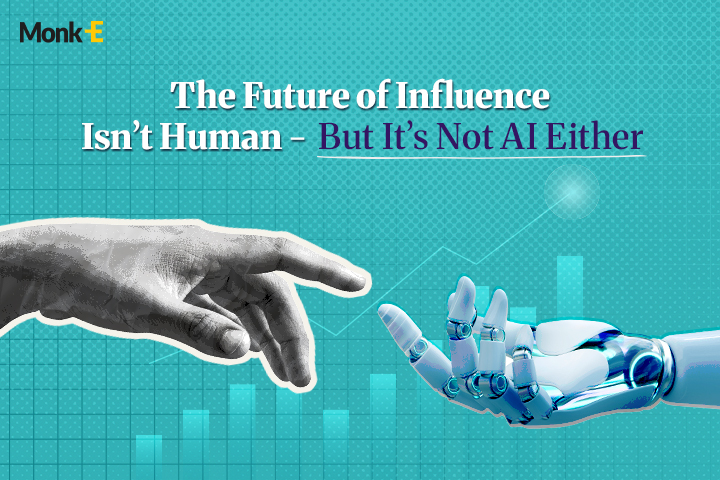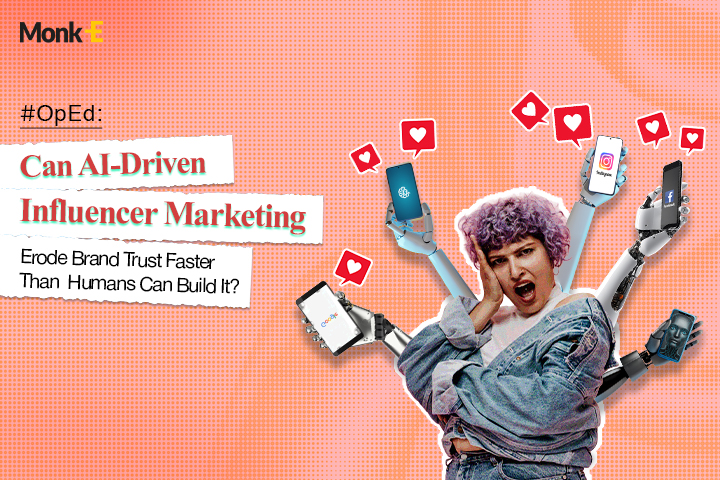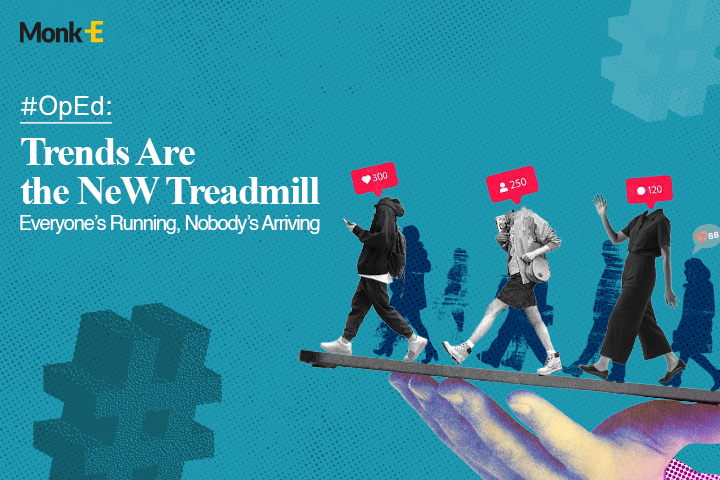The Future of Influence Isn’t Human - But It’s Not AI Either



One scroll through your feed and you already feel it: a sponsored reel, a meme page repost, a virtual avatar posting exactly when you log on. Where does the creator end, and what begins the algorithm? Influence is no longer as simple as “people follow people.” In 2025, it’s becoming an ecosystem - a hybrid dance between human, code, community, and context.
This isn’t a sci-fi thought experiment. It’s already happening in India. Take Kyra, India’s first virtual influencer (created by FUTR Studios) - she’s delivered campaigns with Amazon Prime Video, boAt, and John Jacobs, and has amassed hundreds of thousands of followers. That’s not magic - that’s early proof that influence can wear many faces (or none).
So when we say “The future of influence isn’t human” we don’t mean flesh and bone are obsolete. We mean influence is evolving beyond being purely human, but it will never be just AI either. It will live in the liminal space: the hybrid, the collective, the vibe.
Virtual influencers aren’t new, but in 2025 they’re graduating from Instagram experiments to marketing assets. In India’s marketplace, Kyra is a prime example: a digital personality who exists on feeds, not streets.
But here’s the twist: she’s not aiming to replace creators. Brands use her voice because she can stay on brief, never take a day off, and evoke sci-fi curiosity. She sits at the intersection of consistency + novelty.
Still, Indian audiences crave cultural nuance - a virtual avatar might deliver in aesthetics, but emotional resonance often remains grounded in the human stories around it. Virtual faces may lead campaigns, but the storytelling still needs human hands behind the scenes.
If influence used to be one-to-many, now it's many converging vectors. Meme pages, subreddits, WhatsApp groups, fan accounts - these create a net of influence. The real power lies in collective amplification, not just a single big name.
In India, think of how a meme page amplifies a creator’s one hot take. Or how fandom groups remix moments into evergreen formats. The virality isn’t always from the original post - sometimes it’s from the crowd remixing it.
Brands are already playing this: they seed a meme, then let the network do the work. The real creators become orchestrators of the ecosystem, rather than the singular voice.
Every creator today is quietly a half-AI operator: using tools to generate drafts, image edits, voiceovers, trend discovery. Even big names do it. The future isn’t AI creators replacing humans, but humans using AI as a creative co-pilot.
In India, we already see brands experimenting with AI voices and content assistants. Google’s “Portraits” lets you generate AI-versions of influencers that give advice or commentary, blending AI + personality.
But no matter how smart the algorithm, the creative spark - cultural insight, emotional twist, controversial opinion - often still comes from humans. That friction is where new influence lives.
What if influence isn’t in the person, but in the format? A viral audio, a meme template, a Reels template - these can become more influential than any creator. For example, a trending Reels template can flood feeds globally. Suddenly thousands are riding the same structure. The “format” becomes the influencer, and creators become participants in that influence.
In India, we see creators adapting trends from global markets within hours - plugging in local flavour, remixing the format, and influencing how brands brief content. That tweak in timing, sound, or aesthetic can be the difference between a post fizzling and going viral.
When influence becomes hybrid, new questions emerge: authenticity, trust, and accountability. When a brand pays a virtual avatar - who is responsible? When an AI-generated voice promotes a product - does the audience know?
Indian creators and platforms are already bracing. Some campaigns now mention “AI-generated voice used by brand” as a disclosure. Some creators publicly clarify when parts of their work are AI-assisted. Transparency is becoming a competitive edge.
Emotionally, a perfectly programmed avatar can never cry, fail, or screw up and sometimes those flaws are what audiences love. So the future of influence won’t be flawless, it’ll be honest in its hybrid-ness.
Final Act: Influence as a System, Not a Star
In 2025, the future of influence is like an orchestra: instruments, conductors, acoustics, and even the architecture of the hall matter. It’s not only about who’s on the stage.
Expect influence to be:
- Collective, not solo (fan pages, meme hubs)
- Hybrid, not purely human or AI
- Driven by formats, not just faces
If a single creator used to be the spotlight, tomorrow the spotlight will have many faces - some human, some algorithmic, all part of a system. The creators who thrive won’t just be those with the sharpest voice but those who can conduct the ecosystem.
Read More Articles

#OpEd: Can AI-Driven Influencer Marketing Erode Brand Trust Faster Than Humans Can Build It?
The next time you pause mid-scroll on an influencer video that feels too perfect, check twice - it might not be real.
The lighting’s immaculate. The voice never falters. The smile lands right on beat. And yet, you can’t shake the feeling that something’s missing.
That something is human imperfection, the quiet pulse of realness that makes audiences connect and brands credible.
In 2025, influencer marketing has reached an uncanny stage - where machines can mimic authenticity better than humans can perform it.
And that’s exactly what makes it dangerous for brand trust.
Why Brands Are Hooked on Perfection
Let’s be honest - AI influencers make marketers drool. They don’t get tired, controversial, or expensive. They deliver flawless output, on time, every time.
For brands, that’s seductive. Why negotiate schedules, moods, or revisions when you can just program them?
That’s why we’re seeing a quiet but steady adoption of AI-led creator campaigns:
- Kyra, India’s first virtual influencer by FUTR Studios, worked with certain big brands.
- Globally, Lil Miquela and Imma are racking up luxury endorsements with the reliability of a content machine.
AI promises consistency but in branding, consistency isn’t the same as connection. The danger isn’t that these avatars exist. The danger is when brands start believing efficiency = trust.
Trust: The Currency Brands Can’t Automate
Every ad, post, or collaboration - ultimately trades on one thing: trust. You trust that the influencer actually likes what they’re selling. You trust that the brand means what it says.
When AI steps in, that invisible currency starts to fray.
Think about it: Trust isn’t built in pixels or precision. It’s built in pause - the hesitation, the laugh, the unscripted chaos. The moment a creator stumbles and corrects themselves, you feel like they’re real.
Machines don’t stumble. And that’s the problem.
In influencer marketing, over-polish often reads as over-sell. AI strips away the very friction that signals “I’m not performing, I’m just being.”
A Northeastern University study in 2025 confirmed this: there is likely to be more reputational damage done to a brand’s trust if artificial intelligence-powered influencers, rather than their human equivalents, are involved in selling a product that a consumer is unhappy with.
Because trust isn’t information; it’s intimacy built over time.
What’s Really at Stake for Brands
If influence was once about reach, today it’s about relatability and recall. And recall only works if the emotion behind it feels true.
Brands that go all-in on AI-driven influence risk three long-term problems:
- Loss of emotional credibility- People may remember the ad but forget the brand, because there’s no emotional anchor.
- Erosion of social proof- AI-generated reviews or endorsements blur what’s authentic; soon every testimonial feels synthetic.
- Diminished brand intimacy- When creators become characters, brands lose their human front the person audiences could identify with.
In short: AI can sell a product, but it can’t build a promise.
What Agencies Must Understand and Protect
For influencer agencies, this isn’t about panic. It’s about redefining value. Their real job now? Becoming the custodians of trust.
Agencies that survive won’t be the ones offering the biggest rosters or lowest commissions but the ones that ensure credibility is never compromised, no matter how futuristic the campaign.
They’ll need to:
- Build AI-disclosure norms for clients (“synthetic voice used,” “AI-rendered model,” etc.)
- Offer trust audits as part of campaigns - verifying engagement authenticity
- Develop ethical hybrid models, where creators collaborate with AI versions of themselves transparently
- Craft emotional storytelling frameworks that AI tools can’t mimic grounded in culture, humour, vulnerability
Because when every brand starts using AI, it’s how human your brand feels that will set it apart.
The Indian Lens: Why Trust Hits Harder Here
India’s influencer economy runs not on followers, but on familiarity. Our creators are not just “content machines” - they’re people audiences grow with.
When a Dolly Singh shares a personal anecdote, or an Aastha Shah talks about confidence, audiences don’t see a “campaign.” They see a human reflection.
That emotional glue, humour, honesty, cultural connection, is hard-coded into the Indian viewer’s psyche. Replace it with algorithmic avatars, and you’ll lose more than engagement. You’ll lose believability.
The Future of Influence: The Age of Verified Humanity
The next wave won’t be human vs. AI - it’ll be trust-based vs. transaction-based influence.
We’ll see authenticity labels on content; Brand loyalty scored by perceived honesty not just ROI metrics; Hybrid influencer strategies - where AI handles scalability, and humans handle sincerity
And agencies that sit in the middle - as architects of trust + tech - will define the future.
Because soon, “real” will be the most expensive asset on the internet.
AI may boost performance, but it risks breaking the one invisible thing every brand needs to survive - belief.
Machines can sell faster. But only humans can make us care.
And in a world obsessed with reach, care is the metric that still converts.

#OpEd: Trends Are the New Treadmill - Everyone’s Running, Nobody’s Arriving
Everyone’s going viral. Nobody’s being remembered. The internet’s irony is brutal: the more creators chase trends, the less unique they become.
Scroll through your feed and it’s déjà vu on loop - same sound, same template, same jump-cut smile. Everyone’s dancing to the same audio, hoping the algorithm picks them.
In the chase to be seen, creators are slowly disappearing into sameness.
The Great Copy-Paste Epidemic
Trends used to feel like culture. Now they feel like compulsion.
The moment a Reel goes viral, creators jump on it like a flash sale - remixing the same format till it loses meaning. The result? A feed that looks more like a clone army than a creative industry.
It’s not that trends are bad. They’re fun. They’re fuel. They’re community. But when every creator is sprinting on the same treadmill, no one’s really moving forward.
The Algorithm Whisper
Here’s the uncomfortable truth - no creator starts out wanting to sound like everyone else.
But then the algorithm whispers: “This worked. Do it again.”
And we listen.
That tiny dopamine hit from views, likes, and shares rewires how we think about success. Soon, content becomes less about expression and more about expectation. The algorithm becomes both mentor and monster - a system that rewards imitation while punishing silence.
Creators stop asking “What do I want to say?” and start asking “What’s trending today?”
When Authenticity Becomes a Niche
Originality used to be the baseline. Now it’s a genre.
We praise creators who post raw, imperfect content like they’ve reinvented the wheel but all they did was be human. That’s how warped the bar has become.
Audiences aren’t unaware; they know when something’s performative. What they crave isn’t polish - it’s presence. Not trend participation - but perspective.
The Courage to Sit One Out
Here’s an underrated flex in 2025: not jumping on every trend.
There’s power in restraint - in letting a viral wave pass because it doesn’t align with your voice.
It signals confidence, not absence.
The best creators aren’t the ones who post the most - they’re the ones who know why they post.
Skipping a trend is not rebellion; it’s direction.
The Return of Voice Over Virality
A new creator wave is quietly emerging - not the loudest, not the fastest, but the most intentional.
They tell stories instead of following formats.
They use trends like seasoning, not the recipe.
They create for connection, not the algorithm.
These are the voices building equity while others chase ephemerality.
Because virality fades. Identity compounds.
The Final Word
Trends are the fast food of content - they taste great, they fill you up, but they never last.
Creators need to start cooking again.
Stop sprinting for reach. Build rhythm for resonance.
Because someday, when the algorithm forgets you (and it will), your voice is all that’ll remain.

